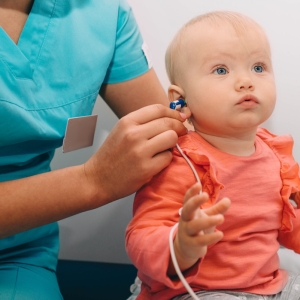Nursing professor uses personal experience to raise awareness of the leading non-genetic cause of hearing loss in infants
May 10, 2023 / by Jacqueline Mazarella- Practice
Two years ago, Michelle Zappas, director of the Department of Nursing at the USC Suzanne Dworak-Peck School of Social Work, noticed developmental delays and language regression in her two-year-old daughter Margot. Her little girl had even stopped responding to her own name.
Zappas, a family nurse practitioner with experience in community healthcare settings, suspected early on that the cause might be the result of congenital cytomegalovirus (CMV) infection, the most common viral infection and leading non-genetic cause of hearing loss in infants born in the United States. For the next 24 months she fought for Margot’s doctors to consider this, and along the way realized there was a significant gap in knowledge among medical professionals – and the general public – about the potential effects of CMV.
She consulted with colleagues Sharon P. O’Neill, clinical associate professor at the Rory Meyers College of Nursing at New York University, and Courtney Rotz, adjunct professor in the Department of Nursing at USC Social Work, to help research and document a case report. The three nurse practitioners recently published their findings, “Congenital Cytomegalovirus Infection: A Case Report,” in the Journal of Nurse Practitioners.
“The fact that as a healthcare professional I went through this, and was dismissed by quite a few medical professionals, has made me very passionate about spreading the word about CMV,” Zappas said. “Not only to the public, but also to the medical community.”
Awareness not proportional to prevalence
Through their research, and Zappas’ personal experience, the authors discovered that the medical community mostly looks for CMV only in very extreme cases in newborns. But symptomatic newborns only account for 10% of CMV cases. Often, as in Margot’s case, newborns may be asymptomatic or have only one or two slight symptoms, and it is not unusual in these cases for newborns to have delayed or progressive hearing loss.
Zappas, O’Neill and Rotz explain in the case report that CMV is a relatively common illness. Many people are exposed to it, and those with robust immune systems do not experience much more than common cold-type symptoms. If a woman acquires CMV during pregnancy, she may be unaware of it. However, if it affects the fetus in utero, it can have neurodevelopment consequences, including hearing loss. Women who are primarily infected during pregnancy are more likely to give birth to neonates who are symptomatic and suffer long-term effects. The authors also point out that CMV is one of the leading causes of childhood disabilities, yet the awareness is not proportional to the prevalence.
There were signs of potential CMV that many of Margot’s doctors missed. Zappas had intrauterine growth restriction causing her daughter to be born very small. Margot also experienced slight delays in her gross motor skills, had some hearing and words early on but then regressed. Even with a medical background and the ability to navigate the health care system, Zappas was often dismissed as a “hysterical mom,” causing the eventual diagnosis for her daughter to be delayed.
“We, as medical personnel, need to be aware that the family may have a bigger insight into what's going on,” Zappas said. “And the family needs to advocate for themselves and their children for whatever those needs are. We can all support that, even for people who do not have as many resources as I did.”
Zappas hopes the case report will also bring more awareness of CMV to the Deaf and Hard of Hearing (DHH) community.
Changing the conversation
Zappas joined the National CMV Foundation and its fight for education, research funding and implementation of a national program to screen every newborn for congenital CMV. Only seven states require CMV education for pregnant women and targeted newborn screening. Only Minnesota has enacted universal newborn CMV screening.
According to Zappas, while a vaccine is in the works, that should not preclude patient education of how CMV is spread and what the symptoms are during pregnancy or in a young infant or toddler. If caught early enough, anti-virals may delay or decrease hearing loss as well as other sequelae such as cerebral palsy and retinitis.
“It needs to be on people’s radar for any child that is having some speech and language delay, lagging in some of their gross motor or fine motor skills, or had a complicated birth or prenatal history,” Zappas said. “This case report is really for nurse practitioners to make this a part of our differential.”
To reference the work of our faculty online, we ask that you directly quote their work where possible and attribute it to "FACULTY NAME, a professor in the USC Suzanne Dworak-Peck School of Social Work” (LINK: https://dworakpeck.usc.edu)
